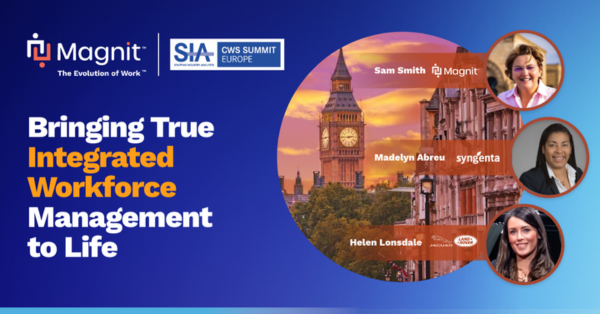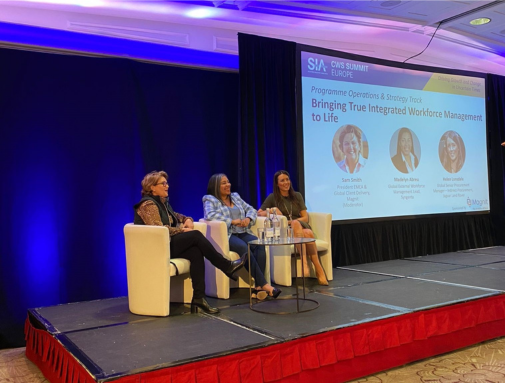Integrated Workforce Management: 4 Keys to Go from Buzzword to Reality
Magnit June 12 2023

CWS Summit Europe is a premier annual event that brings together professionals from the contingent workforce management industry to discuss the latest trends, challenges, and best practices. At the summit, our Magnit panel session titled "Bringing True Integrated Workforce Management To Life" shed light on what integrated workforce management actually means beyond the jargon and discussed the strategies employed by organizations to achieve it.
As President EMEA & Global Client Delivery at Magnit, I hosted the session and had the pleasure of being joined on stage by two Magnit customers: Syngenta’s Madelyn Abreu (Global External Workforce Management Lead HR) and Helen Lonsdale of Jaguar Land Rover (Global Senior Purchasing Manager).
This blog article provides a summary of the four key takeaways from our CWS Summit panel discussion, which featured rich insights and experiences of two unique journeys towards Integrated Workforce Management.

But first, what is Integrated Workforce Management (IWM)?
Integrated Workforce Management refers to the seamless coordination and optimization of all aspects of a company's workforce, including permanent employees and contingent workers. It involves aligning talent acquisition, procurement, HR, and other functions to ensure efficient utilization of resources, cost savings, and access to top talent.
As you can imagine, that can be challenging. The challenges associated with IWM have led many to believe that it’s something of a fairytale. But we’ve seen it in practice!
Our panelists discussed their organizations’ journeys toward Integrated Workforce Management, the roadblocks they faced, and the key takeaways from their experiences.
Key Takeaway 1: Defining the Problem Statement and Aligning with Business Goals
One of the first steps in bringing Integrated Workforce Management to life within your organization is identifying the problem statement and aligning it with the strategic goals of the business. Without this you risk becoming a silo. The power of IWM is in the name – it's ‘integrated’. It involves bringing together different departments and aligning behind the overarching business goals.
During the panel discussion, Syngenta’s Madelyn Abreu highlighted the importance of understanding the business's needs and how the contingent workforce can support its objectives. She stated, "We do not do this program for ourselves. We do this program for the business".
For Syngenta, a global agricultural company who has recently embarked on the IWM journey, defining their problem statement was key. This statement would go on to act as their North Star for the IWM project as a whole and ensure that each action they took would drive the value they wanted. Having experienced growth through acquisitions and mergers, the organization was experiencing fragmentation in hiring and external workforce management processes and needed to realign behind a common vision.
Abreu noted that Syngenta’s problem statement boiled down to “the need to access talent in a timely manner, in the right places, at the right cost”. She added that this definition and a company-wide understanding of the ‘why’ behind the project “became an enabler for the recent strategy and meant it was no longer a Procurement or HR program that we were trying to implement on the business”.
Key Takeaway 2: Stakeholder Alignment and Collaboration
If it’s crucial to be aligned behind a common business goal, it follows logically that Integrated Workforce Management requires effective stakeholder management and collaboration. During the discussion both panelists noted the need to align stakeholders across various functions, including HR, Procurement, Finance, and the hiring managers.
Helen Lonsdale from Jaguar Land Rover emphasized the importance of involving stakeholders from different departments to ensure a holistic approach. When working to involve different stakeholders on the journey, what’s important is to understand the ‘so what’ for them. Lonsdale shared an interesting point about her experience onboarding hiring managers into the IWM vision at Jaguar Land Rover: “They (hiring managers) want the person, the skills and the ability to access the extra capacity quickly. They're less worried about the details of the programme or the process and sometimes what they’re paying if a higher rate can guarantee the skills that they're getting. It's this faster time-to-contract and having the right quality of candidate that’s really important to them and that's what needs to influence our decision making”.
A theme that surfaced throughout the discussion was the need for effective collaboration between HR and procurement teams. As two departments with a vested interest in the contingent workforce – Procurement approaching the topic with a ‘supplier’ lens, and HR with a ‘people’ lens – being on the same page is an important determinant of success. No one is more qualified to talk about this than Madelyn Abreu, who moved from a Procurement role at Syngenta to an HR one as part of the company’s IWM journey. She noted: “...Procurement is more focused on productivity, efficiency and, with the background that I have I was more able to say ‘We need X amount of integrations. We need this type of supplier portfolio’. So we were able to balance that storyline with the HR side in it as well. It was a true partnership where we brought our strands to the table and balanced each other's areas of weakness in a way”.

Key Takeaway 3: Adapting to Changing Skill Sets and Upskilling Contingent Workers
Both panelists acknowledged the evolving skills requirements in their respective industries and the need to adapt to changing demands. Helen Lonsdale discussed the automotive industry's shift toward selling services in addition to cars, requiring workers to learn new skill sets. While Jaguar Land Rover have traditionally focused on upskilling just their full-time workforce, doing the same for the contingent workforce they call upon has also become a priority. “Traditionally the learning and development side of things was just for permanent employees because you'd expect your contingent workforce to come with those skills already”, noted Lonsdale. “But I think where we're increasingly consuming the skills we need faster than we can find them, we need to consider if there should be a mindset shift as to ‘how we develop that talent pool’.”
As a leading global agricultural company, Syngenta faces unique industry challenges and understands the significance of having a fit for purpose workforce to drive innovation and meet evolving demands. Abreu highlighted the importance of a holistic approach to resources, looking beyond traditional roles and considering the potential for upskilling contingent workers. “We are basically trying to hold on to the resources that show the right skills for the job that we need them to do today”, noted Abreu. “But also, there is a very interesting rotation system to make sure that we develop further skills for workers... So workers are rotating from one production line to the other, from a lab to a greenhouse...from harvesting corn, to pollinating, which are completely different skills. So, I would say we're trying to also attract workers with the key basic soft skills. And then developing those technical skills with them”.
By investing in the development of both their workforce as a whole – both full-time and contingent - organisations can build a more versatile and adaptable workforce that’s ready to meet continuously changing business needs.
Key Takeaway 4: Cost and ROI are Top of Mind
In the current economic climate, where organizations are under increasing pressure to do more with less and achieve significant cost savings, Integrated Workforce Management is not simply another big expenditure project. With economic uncertainties and competitive pressures, businesses are seeking ways to efficiently optimize their workforce and reduce unnecessary expenses.
Integrated Workforce Management offers a strategic approach to aligning workforce needs with business objectives, enabling organizations to optimize their contingent workforce while minimizing costs.
Interestingly, for both panelists, cost savings were top of mind in 2023 but came as a result of the efficiencies that an integrated approach to workforce management would provide in the medium and long term.
As Madelyn put it, IWM done right is “all about simplification, automation, optimisation. And by extension, that brings cost savings.”
Helen added, “I think that cost saving is a great benefit and almost a by-product of all the good stuff you do beforehand. For me, it's about driving value...it's about creating agreement around your program, that people will want to pull on, not pushing it onto them. Because ultimately that’s going to drive the buy in from everyone. That's where your ROI really comes back in spades”.
Summing up
Achieving true Integrated Workforce Management requires organizations to define their problem statement, align it with business goals, and involve stakeholders from different functions. Collaboration and effective communication between HR, Procurement, and other departments are essential to ensure a holistic approach. Adapting to changing skill requirements and upskilling contingent workers contribute to building a versatile workforce.
By implementing these key strategies and learnings, organizations can optimize their workforce, enhance operational efficiency, and achieve their business objectives. Integrated Workforce Management serves as a catalyst for success in today's dynamic and competitive business landscape, providing a strategic advantage by effectively managing the entire talent ecosystem.
Find out more about Magnit’s Integrated Workforce Management Platform.
If you’re interested in learning more about how Magnit is helping organizations implement winning contingent workforce programs globally, please contact a Magnit representative at info@magnitglobal.com.
Disclaimer: The content in this blog post is for informational purposes only and cannot be construed as specific legal advice or as a substitute for legal advice. The blog post reflects the opinion of Magnit and is not to be construed as legal solutions and positions. Contact an attorney for specific advice and guidance for specific issues or questions.